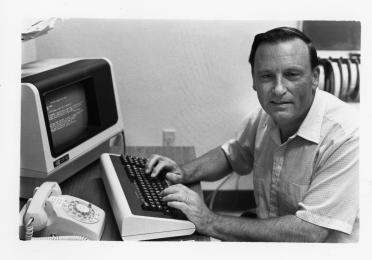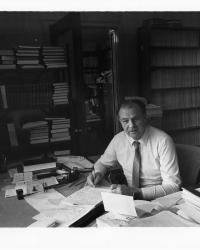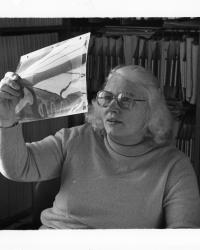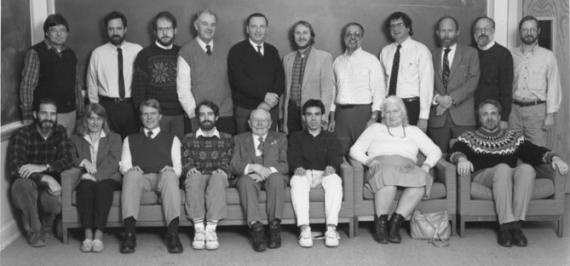Early Astronomy Faculty
From the creation of the Astronomy Department in 1891 until 1965, there was only one professor of astronomy at a time at the University of Washington. Below are short biographies of the astronomy professors during this period.
Joseph M. Taylor
This professor of mathematics created the astronomy department in 1891 and served as its sole professor. In order to learn more astronomy, Prof. Taylor studied as a special student at Lick Observatory, California, in 1890. When he returned from Lick, he created the astronomy department, and with $3000 allocated from the regents, purchased the new telescope and built the first observatory.
Samuel L. Boothroyd
Professor Boothroyd joined the faculty in 1912. He introduced astrophysics into the course offerings, and worked in close contact with the astronomers of the Dominion Astrophysical Observatory in Victoria, BC, Canada. While at the UW, Prof. Boothroyd published papers on the spectra of binary stars. In 1920 he hosted the first astronomy conference at the UW, a meeting of the Astronomical Society of the Pacific attended by at least 20 astronomers. In 1921, Prof. Boothroyd moved to Cornell University, after which the number of astronomy courses at the UW declined. Boothroyd later had a small observatory named for him at Cornell, the Hartung-Boothroyd Observatory.
Herman Zanstra
Professor Zanstra (1894-1972) was appointed to the faculty in 1926 as assistant professor to teach general astronomy. He had just earned his Ph.D. at Cal Tech, where he had written his famous paper, “An Application of the Quantum Theory to the Luminosity of Diffuse Nebulae.” This paper gave for the first time a quantitative treatment of the luminosity of gaseous nebulae and comets. For instance, his method, which is still taught today as the “Zanstra Method,” was applied to understand the luminosity, spectrum, and shape of the tail of Halley’s comet, which had visited in 1910. Zanstra’s pioneering work in astrophysics was, however, little appreciated in Seattle at the time, and this probably led to the brevity of his stay. After publishing a few papers at the UW, Zanstra took a position at the Imperial College of Science and Technology in London in 1928, and eventually settled at Amsterdam University in his native Holland.
Theodor S. Jacobsen

As a boy, Prof. Jacobsen emigrated to America from Denmark, studied chemistry, applied mathematics, and astronomy at Stanford University, and then obtained his Ph.D. in 1926 from the University of California Berkeley. He became a staff member at Lick Observatory, but due to a muscular strain incurred while moving the big telescope, he was unable to continue as an observer and thus sought a less physically strenuous position. In 1928 he was hired by the UW to replace the departing Prof. Zanstra and teach astronomy as well as courses in mathematics, such as trigonometry and theory of investments, and to open the observatory to the public one evening a week. Besides courses such as these, Jacobsen taught navigation and practical astronomy during World War II. The curriculum was slowly expanded with a number of intermediate astronomy courses (but never an astronomy major). He also hosted numerous conference at the UW during his 37 years as sole UW astronomy professor, including a small 1940 conference attended by Edwin Hubble.
Dr. Jacobsen’s research over the years focused on the spectra and motions of variable stars, especially of the Cepheid type. At the end of his career he delved into the history of early astronomy. This work finally appeared in 1999 as Planetary Systems from the Ancient Greeks to Kepler. Prof. Jacobsen passed away just after his 102nd birthday.
The Department of Astronomy steadily grew after George Wallerstein and Paul Hodge joined Theodor Jacobsen as the first faculty in 1965.

George Wallerstein
George Wallerstein (1930-2021) was a tenured Associate Professor at UC Berkeley in June 1964 when the UW invited him to Seattle to give advice on how astronomy offerings should be configured. George advocated for an independent department with an astronomy Ph.D. degree. In September 1964 he received an offer to chair the Astronomy Department. The prospect of being able to start a new department was exciting, but what really sealed the deal for George were the proximity of the mountains and the “interesting” northwest weather. He arrived in the summer of 1965 and served as department chair until 1980. He became an Emeritus Professor in 1998, and was later awarded the Henry Norris Russell Lectureship of the American Astronomical Society in 2002 to commemorate his research in stellar evolution.

Paul Hodge
Paul Hodge (1934-2019) was born and grew up in western Washington. His avid interest in astronomical studies led to a Ph. D. degree from Harvard. Paul was an Assistant Professor at UC Berkeley in 1964 when he got an offer to become a faculty member in the newly-expanding Astronomy Department at the UW. Paul's ties to the northwest and his love of the outdoors made for an ideal fit with the environment in Seattle. Paul served as editor of the Astronomical Journal from 1984 to 2004. He is known widely for his research on galaxies, star clusters, and meteoritics.

The next faculty members to arrive were Karl-Heinz Böhm (1967) and Erica Böhm-Vitense (1968).
Karl-Heinz Böhm
Karl-Heinz Böhm (1923-2014) was Professor of Astronomy at Heidelberg University when he and his wife Erika Böhm-Vitense were contacted by George in 1967 (who had met them years earlier) to ascertain their interest in appointments at UW Astronomy (starting in 1968). When they learned that they would have convenient access to the UW IBM 709 computer instead of having to send IBM cards to another campus with a turn-around time of several days, they looked favorably upon the offers. Karl-Heinz was appointed as a professor. He was known as a particularly excellent teacher and mentor of graduate students. His studies of white dwarf stars and Herbig-Haro objects were his life-long astronomical passion.

Erika Böhm-Vitense
Erika Böhm-Vitense (1923-2017) held a research position at Heidelberg University before coming to UW in 1967. She started out by taking a research position in the UW astronomy department. When it became possible for both members of a married couple to be appointed to faculty positions in the same department (due to changes in university anti-nepotism rules), Erika became a professor in the Astronomy Department. Erika was well-known for her work on stellar abundances, rotation and convection, and later wrote a much-used textbook on stellar astrophysics.
More faculty, support staff, graduate students, postdoctoral fellows and eventually undergraduate majors followed over the years. See the department faculty pictured in 1990.

The Telescope and Observatories
In 1891, the Regents of the University appropriated $3000 to build an astronomical observatory. These funds had been allocated by the legislature when Washington became a state in 1889, and had to be spent quickly in order that they not revert to the State. So after such splurges as a grand piano, the Regents allocated money for an observatory. Professor Joseph Taylor taught astronomy at the time, and had just returned from a year at Lick Observatory. Compared to the instruments at Lick, $3000 was a small sum, but nevertheless sufficient for a good quality, instructional telescope. Dr. Taylor enthusiastically pursued the project, consulting with Prof. Schaeberle at Lick on the instruments to be purchased.
Given the small budget, Prof. Taylor settled on a 6-inch diameter objective lens made by John Brashear of Allegheny City, Pennsylvania, with the mechanical components of the telescope provided by the Warner and Swasey Co. of Cleveland, Ohio. Dr. Taylor designed an observatory building himself and employed two local carpenters to erect the frame and a mason to build the brick pier on which the telescope would be mounted. He then completed the building himself, working from sunrise to 8 am, then teaching classes all day, and resuming work on the observatory from 3 pm to sunset.
This first wooden-frame observatory lasted, however, only three years. When the University moved to its present campus in 1895, there were some building materials left over from the construction of Denny Hall (the first structure on the new campus). Taylor had these materials used to construct a new stone structure; this new observatory, which survives today, thus became the second building erected on the present campus. It is listed on the State Register of Historical Buildings. The dome and telescope were removed from the old observatory on the downtown campus, and moved by wagon to the new observatory near Denny Hall, where they remain today. A German transit telescope, bought in the early 20th century, was later added for instruction in precise measurements of star position and determination of longitude and latitude.
The Theodor Jacobsen Observatory is the second-oldest structure on the UW campus, and continues to offer celestial views of the wonders of the universe. Want to attend events at TJO? Check our page on the Jacobsen Observatory.
Related Links
- The Contributions of the Böhms to Stellar and Circumstellar Astrophysics, G. H. Herbig, 1994
- Theodor Jacobsen: a century of stargazing University Week archives, September, 1999.
- An Historical Study of Astronomy is Published, With Help From Dedicated Friends A&S Perspectives Winter, 2000.
- History of the University of Washington Astronomy Department: 1965-1995 Julie Lutz, AAS Meeting #225, 2015.
- The Theodor Jacobsen Observatory: A look at history and the stars The Daily UW, 2022.